Where to Stay in Boston: A Complete Guide for First Timers
Boston is a fascinating city full of rich American history – especially around the American Revolution – with far too many colleges and universities to count which gives it a very young feeling, and an undercurrent of rebelliousness that runs through its entire history.
Add to that some excellent sports culture and cool architecture, and it’s a cool city to visit.
The first thing to know about finding a place to stay in Boston is that nearly everything is expensive. It’s an expensive city in general – it’s consistently in the top 10 highest cost of living cities in the country – and hotels are not exempt from that trend.
It’s a little more affordable in shoulder seasons and the offseason, but if you’re visiting in the summer, it’s not going to be cheap.
The second thing to know is that it’s a relatively compact city.
Similar to San Francisco, which is where we met and lived for a decade, it’s constrained by water on three sides, which means it can only sprawl so far.
Central Boston is extremely walkable, and it’s almost perfectly flat. Anywhere you stay in the central corridor, which stretches from the North End to Fenway Park, roughly, is going to be convenient.
In this guide, we’re going to share our take on where to stay in Boston, based on our own experience and point of view, to help you find the perfect place to stay for your trip.
For each area, we’ll give you an overview of the neighborhood, then dive deep into the pros and cons of staying there, a few highlights that we love, and some handpicked places to stay.
Sound good? Let’s get into choosing the best place to stay in Boston for your particular style and budget.
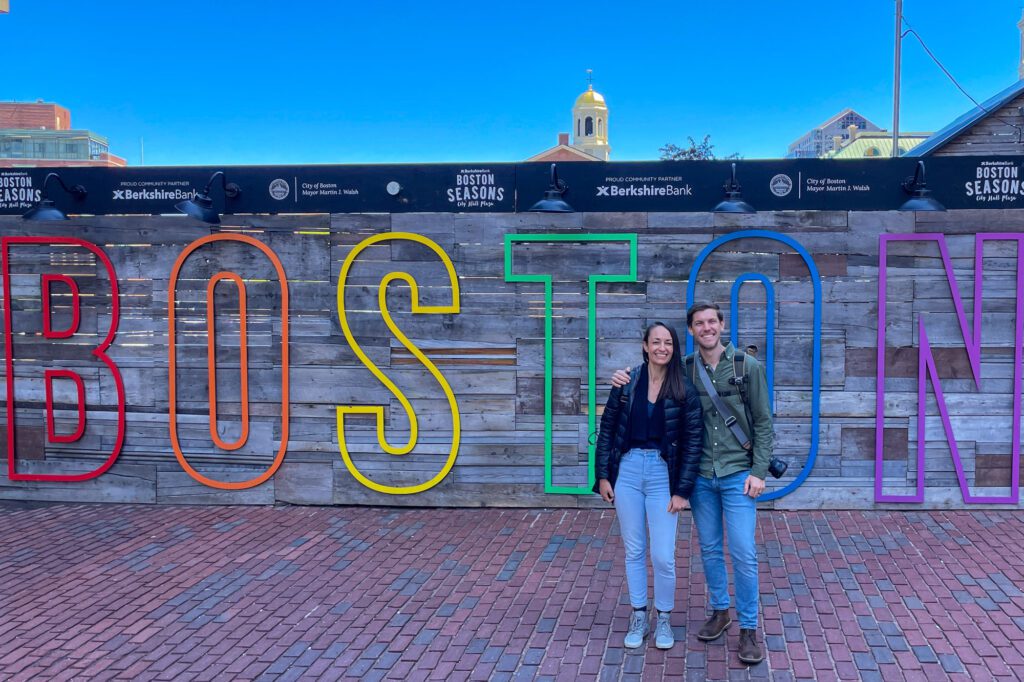
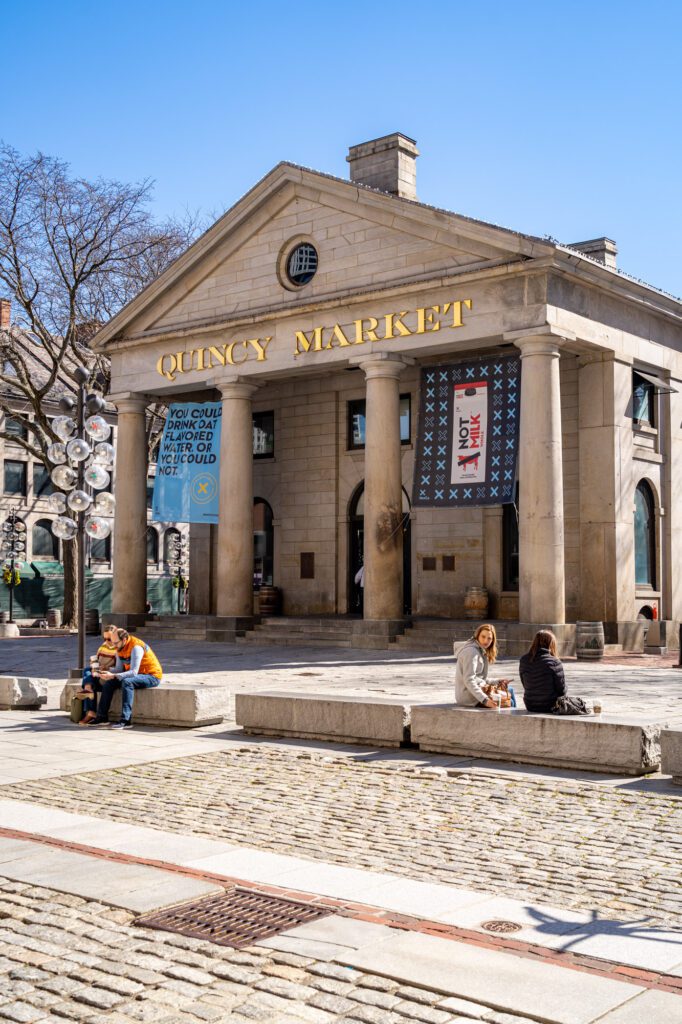
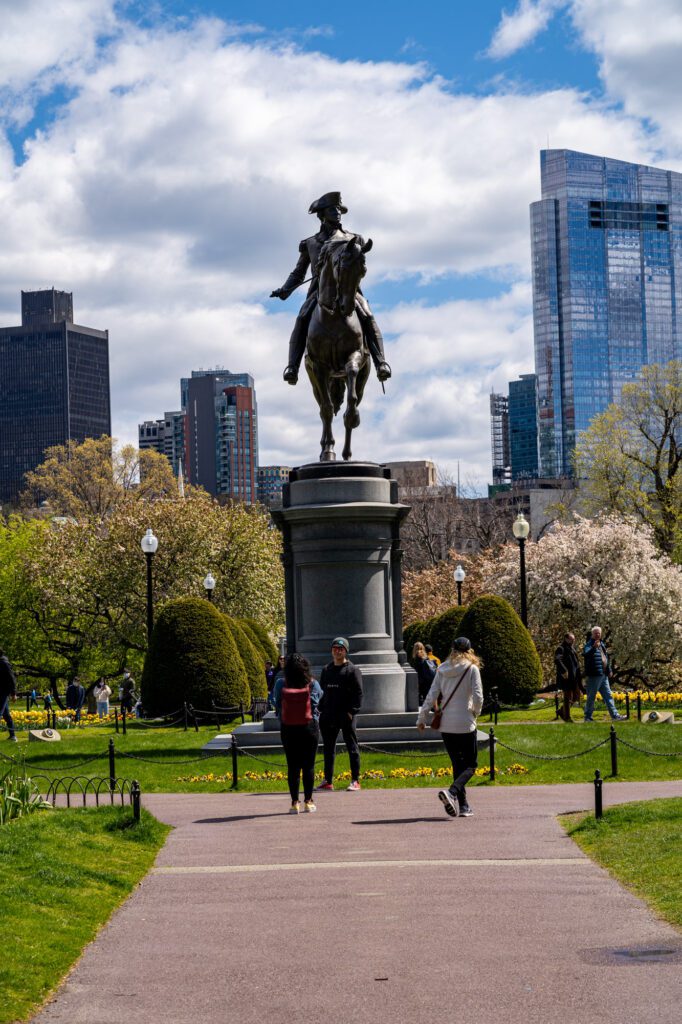
Disclaimer: Some of the links in this post, like hotel links, are affiliate links, meaning at no additional cost to you, we make a little bit of money if you click through and book. That being said, we would never recommend something to you that we don’t stand behind 100%.
Where to Stay in Boston: The Best Places to Stay
In this guide, we’re going to cover – in detail – three great places to stay in Boston.
For each, we’ll give you our honest take on the pros and cons, give you some neighborhood highlights that we enjoyed, and point you to two to three different hotels to start your search.
We’re strong believers that the best way to do it is to first pick the neighborhood you want to stay in, then pick a place within that neighborhood.
That’s what you’ll see below – we’ve organized this guide to first cover the neighborhoods, then recommend some cool places to stay within each neighborhood.
Before we get into it, you should know that short term apartment rentals in Boston (like the ones you might find on say, Airbnb) are HEAVILY regulated to protect the local housing market, which means they’re not really a great option here.
Which is kind of unfortunate, because we do like staying in apartments when we’re traveling, especially if we’re in a city for more than three or four days.
We’re not going to cover every single neighborhood you COULD stay in here, because Boston is a relatively compact city.
Unlike a city like Paris or London, where there’s a nearly unlimited number of cool neighborhoods that offer something a little different, there are only a few places that really deserve to be on the list.
We’re strong believers that the best approach is to first pick the neighborhood you want to stay in, then pick a place within that neighborhood.
That’s what you’ll see below – we’ve organized this guide to first cover the neighborhoods, then recommend some cool places to stay within each neighborhood.
Now, we are aware that half of you reading are ready to throw your left shoe at the screen, screaming “JUST TELL ME WHERE TO STAY ALREADY!”, so here’s a quick summary of the much longer guide you’ll find below.
Our overall recommendation is to stay in Back Bay, which is a fun, hip area that’s a little bit removed from the main tourist sites (still just 10-15 minutes on foot), which means it’s less hectic.
Walking distance to Copley Square (where you’ll find Trinity Church and the incredible Boston Public Library) and the Public Garden, the location is great.
Our top pick here is easily the new (ish) CitizenM Back Bay.
We love CitizenM Hotels – we’ve stayed at their other location in Boston, along with several others around the world – and they’re consistently top tier in experience and value.
Other good options are the stylish Eliot Hotel, which is relatively affordable with surprisingly spacious rooms, or at the Newbury Guest House for a more intimate experience in a smaller hotel.
The most convenient location in Boston is Downtown Boston, and it’s especially nice for first-timers who want to be close to all the highlights.
This is where it all went down – the Boston Massacre, the Boston Tea Party, and even more important Revolution-era events.
From the outside, it looks like it’s all modern skyscrapers, but once you’re in it, you’ll start to notice historic brick buildings like Old State Hall mixed in.
Stay at the Godfrey Hotel, which has our favorite coffee shop in Boston in the lobby and gets consistently stellar reviews, or the Harborside Inn, which is in a great location mere blocks from the Old State House and the Boston Tea Party Museum.
If you’ve been to Boston before and you’re looking for something a little different, stay in the South End.
As soon as you leave Back Bay heading south and cross I-90, the neighborhood changes almost immediately. It’s all red bricks and brownstones down here, with some of Boston’s best food and drinks and a more residential, local feel to it.
The Revolution Hotel is, by far, our favorite option in the area, and is probably where we’ll stay for our next trip to Boston.
If you’re on a tight budget, there’s no single neighborhood that has the cheapest places to stay.
There’s the HI Hostel in the Theater District, which has both dorms and private rooms (though the private rooms aren’t really that much more affordable than other budget hotels in Boston).
Despite the excellent location, the Harborside Inn is actually one of the more affordable options in Boston.
What about the North End? You’re not going to find the North End in this guide. The North End doesn’t have all that many places to stay, and the few it does have aren’t really in the parts of the North End that, well, make it the North End.
We think it’s a better option to stay elsewhere and come to the North End for an afternoon or evening.
What about Fenway? If you’re going to Boston to see a Red Sox game at Fenway Park, then staying near Fenway would be a great option. Specifically, at the Verb Hotel.
However, for other people, we wouldn’t recommend staying here. It’s a little loud and boisterous, and a little… fratty?
Good nightlife, but that usually means it’s not the best place to stay, at least if you value a good night’s sleep (like we do).
Plus, it’s pretty far from just about everything you’re going to want to see in Boston.
Where We’ve Stayed in Boston
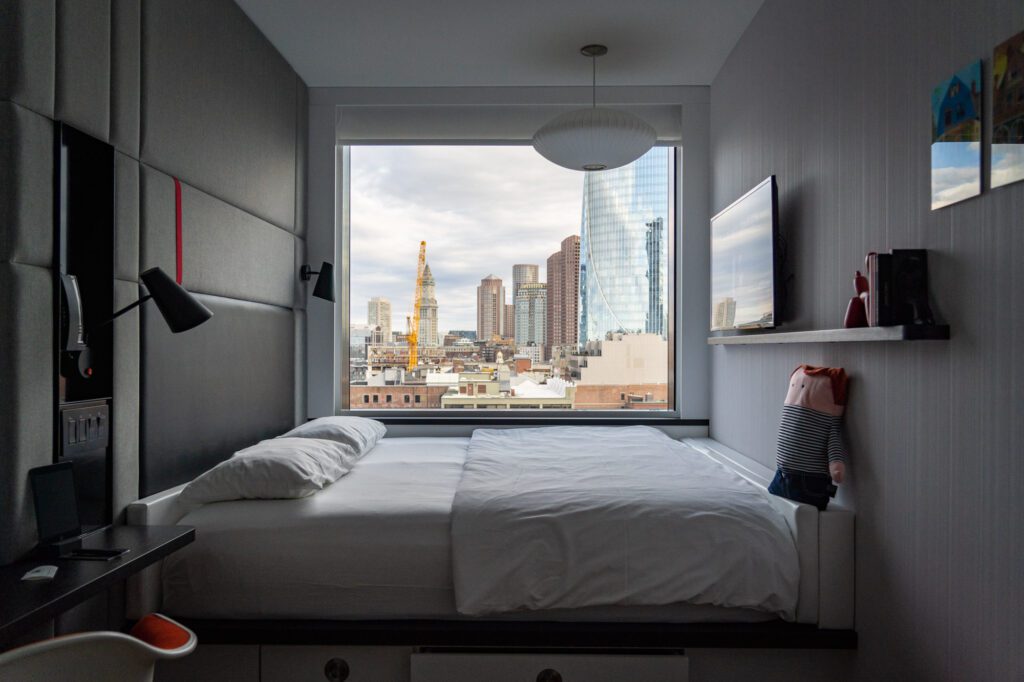
We spent five days in Boston, and we stayed at the CitizenM Hotel at North Station, which is in the complex where the TD Garden (Boston’s main sporting venue) is.
We love CitizenM Hotels – they’re modern, they’re comfortable, the staff are exceptionally friendly (in this case, they helped us troubleshoot an IT issue), and they’re relatively affordable. We’d recommend the hotel.
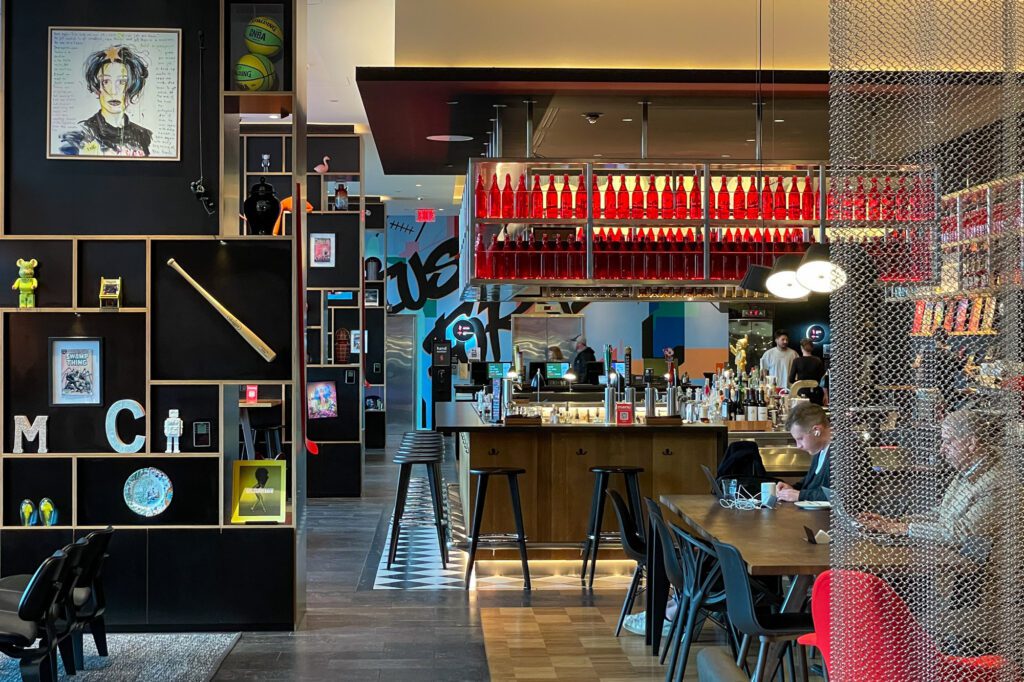
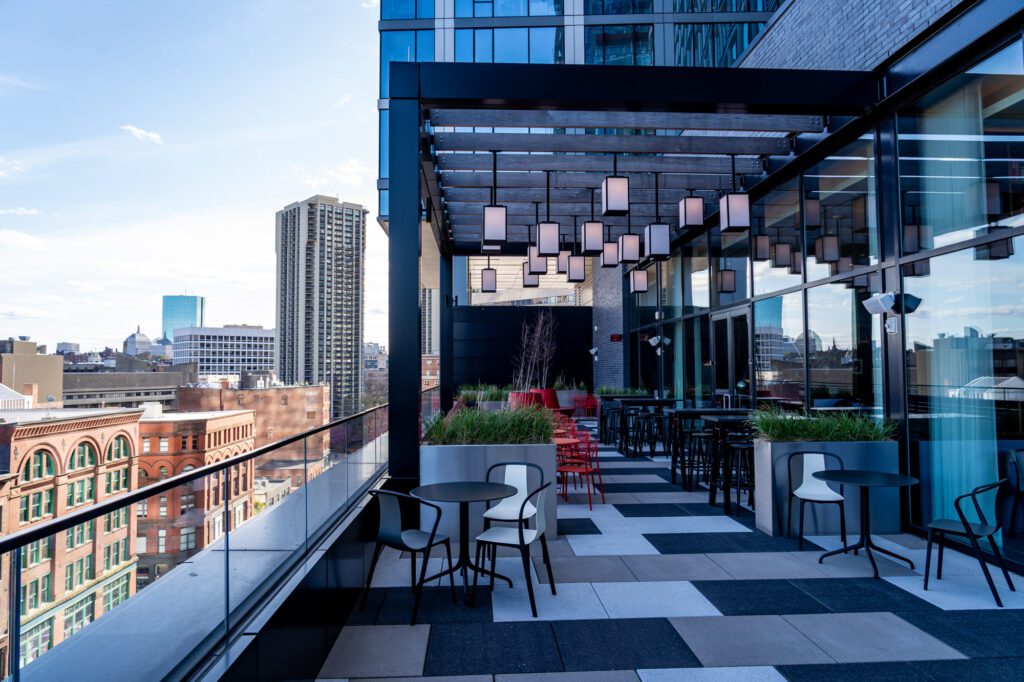
The location isn’t the worst, but it also isn’t the best. We walked everywhere – the North End is a 5-10 minute walk, the Old State House is 10 minutes away, and Boston Common is 15-20 minutes (through Beacon Hill).
It is well-connected via the T – that’s Boston’s version of the Subway – which totally makes sense when you think about Celtics and Bruins games being there.
Back Bay and the South End were a little further away than we’d like, which is why you’ll see us recommending neighborhoods further south below.
The most important thing to know about the specific area around the hotel is that you’ll be spending exactly none of your time there, unless you’re going to a game or concert at the arena. It’s not that exciting. At all.
If you like the idea of walking out your front door and having the best of Boston at your fingertips, this probably isn’t the right place to stay.
Again, love the hotel – CitizenM is our favorite hotel chain in the world (we’ve stayed at 3+ locations in the past year or two) and the location isn’t particularly bad.
Buuuuut… there are definitely better areas to stay in Boston.
There’s a newer CitizenM location in Boston’s Back Bay – our favorite part of the city – that we’d take a look at if you want the same concept, but in a much more charming and centrally located neighborhood.
Back Bay: The Coolest Place to Stay in Boston
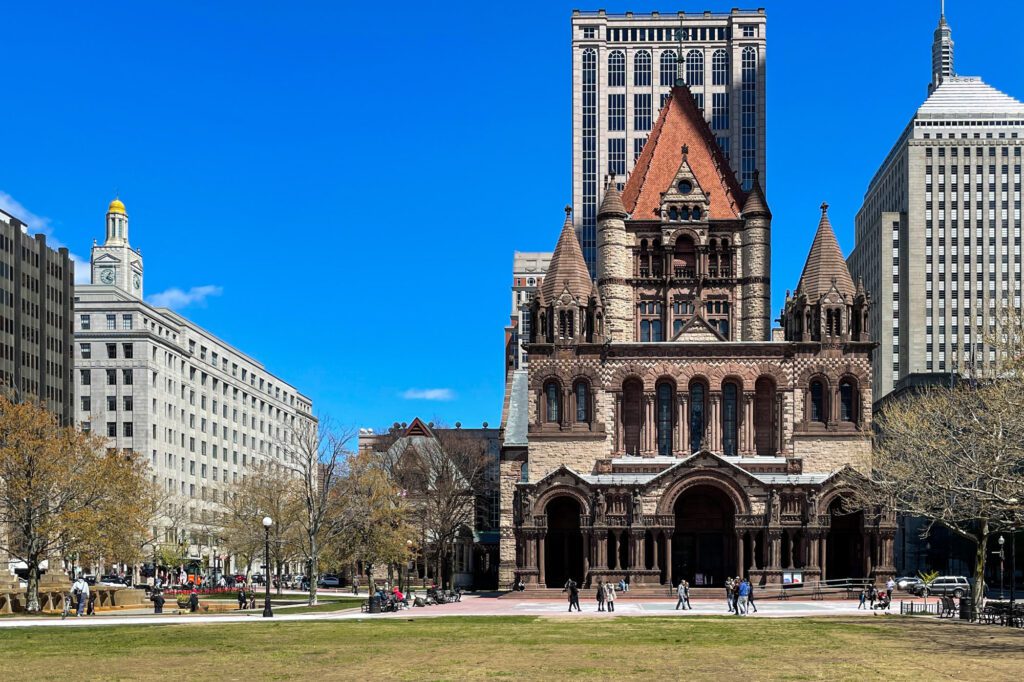
Back Bay is our number one recommendation for staying in Boston. Unfortunately, we didn’t stay there on this trip, but on our return trip, this is absolutely where we’re going to base ourselves.
Walking through Back Bay is a delight. Most of the buildings are charming red brick, which we just don’t get on the west coast (because earthquakes) and they get us every time. Back Bay is full of brick.
As we walked down Newbury Street – the shopping corridor in Back Bay where you’ll find all sorts of name brand stores, from Indochino to Patagonia – we stopped at the corner of Newbury and Hereford, where a brutalist monstrosity breaks through the sea of red brick.
That building, which is all concrete and 90 degree angles, is *checks notes* the School of Architecture? It feels very much out of place, but in some ways, that’s kind of refreshing (and I’m sure architects appreciate the contrast).
Copley Square is the other place in Back Bay that we should probably talk about, because it holds a couple of gems.
First is Trinity Church, which is gorgeous inside and out and was recommended to us by not one but TWO walking tour guides. The audio guide is worth it!
The second, which is completely free, is the Boston Public Library, which is a gorgeous building at the western end of the square.
It’s free to go inside, and the eastern wing (the McKim Building, at the entrance on Copley Square) is a an impressive work of art, with romanesque (or Greek?) columns, paintings in the grand staircase, and a reading room called Bates Hall that is just as grand as the entryway.
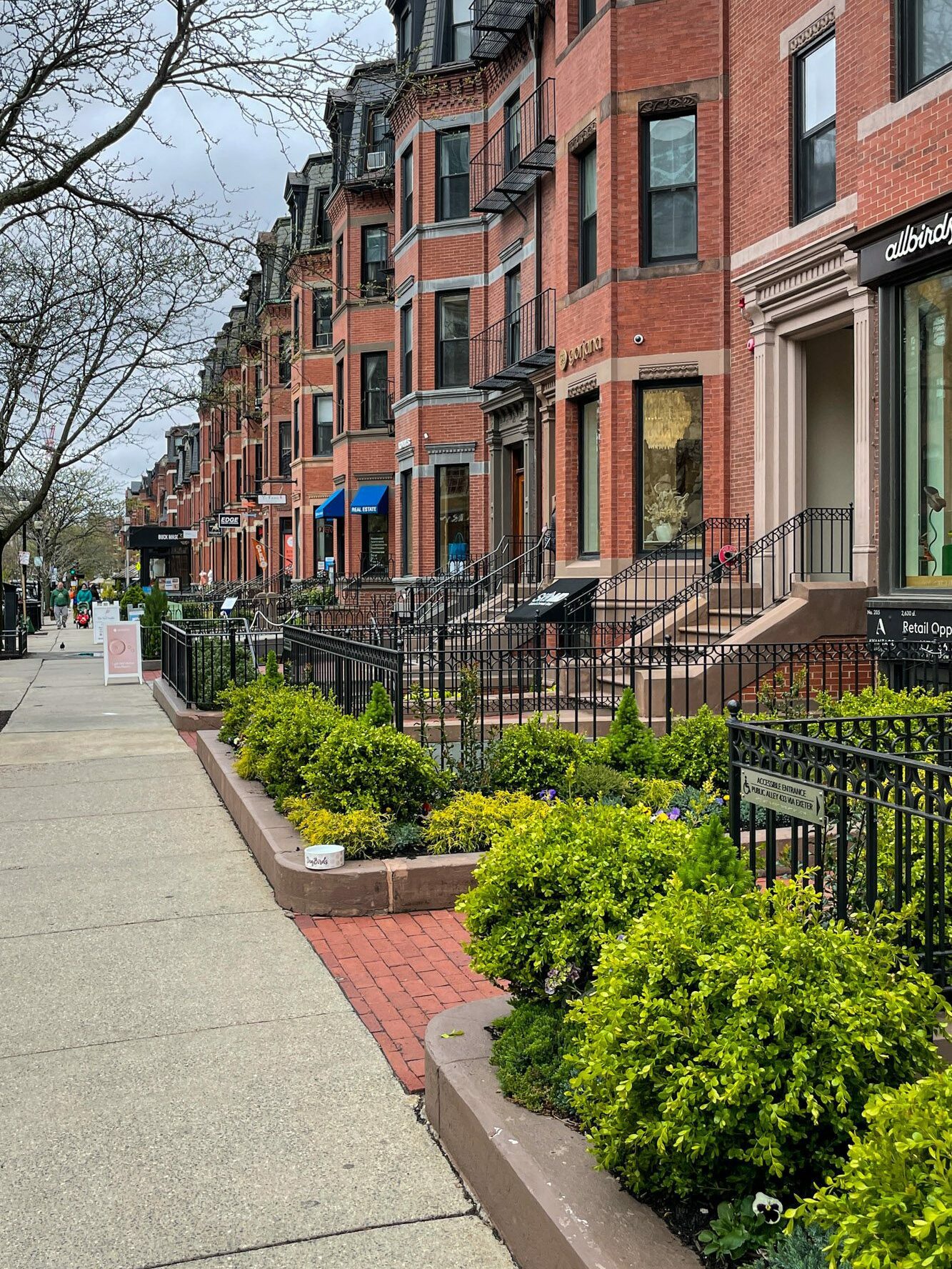
Pros and Cons of Staying in Back Bay
Here’s our take on the pros and cons of using Back Bay as a home base in Boston.
Pros of Staying in Back Bay
It’s a nice location. Bordered by the Boston Public Garden, Downtown, Fenway, and the South End, you’ve got some of Boston’s coolest areas within walking distance.
The only thing that’s a little further away is the North End, which is worth spending an evening exploring.
It’s charming. We’re suckers for the red brick buildings, which we NEVER get in San Francisco because they’ve been knocked down by earthquakes (or, people are scared they WILL be knocked down in the near future).
Back Bay is full of brick! Plus, the tree-lined Commonwealth Avenue Mall is an exceedingly pleasant place for a walk (and dog-watching, one of our favorite pastimes).
Cons of Staying in Back Bay
It’s pricey. It’s easy to understand why this is one of the more exclusive – and by that, we mean expensive – neighborhoods in Boston as you stroll the tree-lined streets surrounded by red brick buildings. That, of course, translates into higher hotel prices.
You probably will be eating and drinking elsewhere. While there are certainly some gems mixed in, this area has a lot of chains. Dunkin, Chipotle, and the like. You may find a couple of independent spots that you’re into, but plan on dining elsewhere (like the North End or the South End).
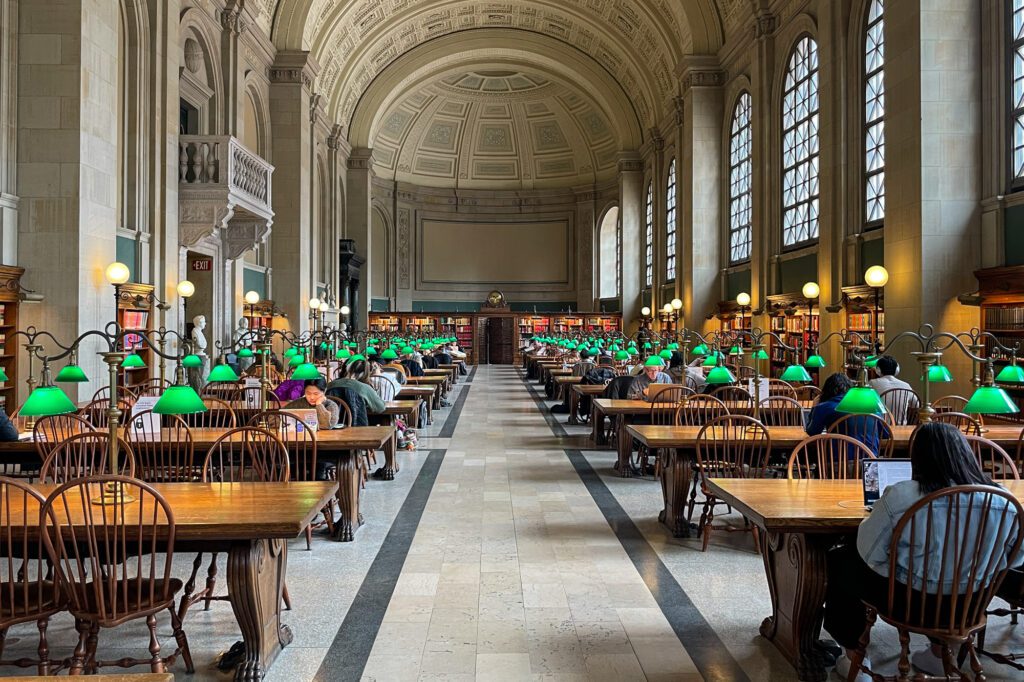
The Best Places to Stay in Back Bay
Here are some places to stay in Back Bay that caught our eye.
CitizenM Back Bay: Our Top Hotel Pick in Boston
As we’ve already mentioned, we love CitizenM Hotels, and we would put the CitizenM in Back Bay at the top of your list of places to stay.
CitizenM – a Dutch hotel chain – has properties worldwide, and we’ve stayed in three of them at the time of writing (including their other location in Boston, and we’d strongly recommend this location instead).
Which, spoiler alert, is their whole thing – every CitizenM room around the world is nearly identical, with a huge bed, blackout curtains, and a compact footprint.
In a city full of expensive, old school, hotels, this is a nice, refreshing, modern change of pace that we very much appreciate.
They’re a Dutch hotel chain that has basically made staying in a hotel super easy and streamlined, with all the amenities that modern, younger travelers are looking for (USB charging, climate controls via iPad, and more) while simultaneously stripping out the unnecessary pieces (fluffy robes and slippers or sitting areas, for example) to offer a great value.
The other thing we like is that, in the interest of simplicity and ease, they’ve stripped away all the slightly different room types you find in most hotels (small vs. small deluxe vs. small deluxe with partial city view), and there’s exactly one room type available: a small room with a king bed.
Not ideal for groups who aren’t comfortable sleeping in the same bed (though, it’s probably about the same price to get one room here as it is to get two rooms at most other SF hotels), but perfect for couples and people who don’t mind sharing a bed.
The location is great. It’s on the western edge of Back Bay, a couple of blocks from the riverfront path (and the bridges over to MIT and Cambridge) and a short walk from Copley Square.
Oh, and no silly “amenity” fees added on! No parking or pets, though.
The Charlesmark Hotel: A Good Value
The Charlesmark Hotel, which is a half block away from Copley Square, is probably the best value in Back Bay.
It’s right across from the Boston Public Library, and the rooms are relatively affordable given the location in luxe Back Bay (remember, NOTHING is cheap in Boston).
The Queen rooms are pretty spacious at 240+ square feet (they also have standard rooms with full beds and 140 square feet, and even smaller budget rooms…with no windows).
Rooms are simple and stylish, with light wood accents and stylish tile in the bathrooms. Nothing ostentatious, but they’re well thought out with desks and seating areas.
There’s a Mediterranean-inspired cafe on the ground floor with a nice outdoor patio, and complimentary continental breakfast – nothing extravagant, just fruit, granola, coffee or tea – if you need a quick on-the-go meal before heading out for the day.
Newbury Guest House: A More Intimate Experience
The Newbury Guest House is a relatively simple place to stay on the western end of Back Bay, right on Newbury Avenue just a few blocks to Copley Square.
It’s a historic brownstone that has been transformed into a small guesthouse, with just 35 rooms.
Despite the somewhat small hotel, there are two French inspired in-house restaurants – a wine bar and a brasserie – if you don’t want to leave the premises for a meal.
They have four room types, the largest of which has big bay windows and views of downtown Boston. They also have smaller, more affordable rooms, some with two queen beds.
The beds are comfortable, there’s a refrigerator in every room, and they have fluffy bathrobes waiting for you. Parking, if you need it, is also available at $30 a night (with in and out privileges), which is nice if you have a car.
The Copley Square Hotel: A Solid Mid-Range Option
Despite being called the “Copley Square Hotel,” this place is actually not on Copley Square. However, it is only a block away, so we’ll count it.
This solid midrange hotel is in the heart of one of the best neighborhoods in the city, but you’d never know it if you’re looking at the price (remember, nothing is cheap in Boston). It’s also the second oldest continuously operating hotel in the city, which is a cool piece of history.
Rooms here are going to be minimalist, giving you everything you need for a good night’s sleep without any of the more luxurious perks like plush bathrobes and fuzzy slippers.
Which are absolutely a nice-to-have, especially if the room comes at a more affordable price (are you willing to pay an extra $50 a night for those extra touches? We definitely aren’t).
Despite the “minimalism,” they’re definitely above average in size – the smallest room (“cozy”) is still 175 square feet, and bigger rooms get up to 300.
They basically have two types of rooms, with a couple of configuration options for each. You’ve got the basic hotel rooms, which come in a “cozy” variety with very little space at the lowest price, and bigger queen and two-queen rooms.
Then they have studios, which have a little more room including dedicated work space in the form of a desk and chair with side table. They also have corner king studios, with views of Boston.
Overall, a nice home base for exploring Boston, even if it’s not ACTUALLY on Copley Square.
Heads up, because I saw multiple reviews complaining about this – there are no fridges or microwaves (or tea and coffee) in the rooms, and there is no onsite restaurant.
Downtown Boston: The Best Place to Stay for Short Trips (2 Days or Less)
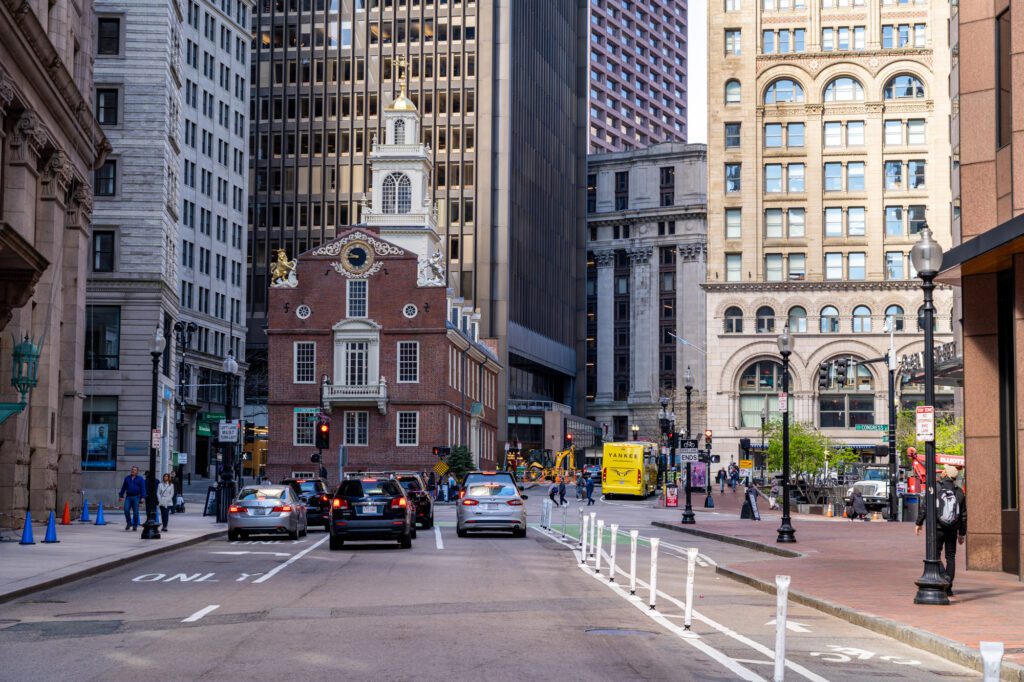
Coming from the west coast, where our cities are relatively young and, in San Francisco’s case, have been leveled to the ground in living memory, Downtown Boston is a trip.
There are parts of the city that could be just about any big city’s downtown core, with towering skyscrapers and people in business suits bustling about, talking on their Airpods on their way to their next important meeting.
But there are also parts of the city’s downtown area where you’ll find buildings made of warm, red brick that are hundreds of years old.
Or a cemetery with dates from the 1800’s featuring a who’s-who of the American Revolution – Sam Adams, John Hancock, and more.
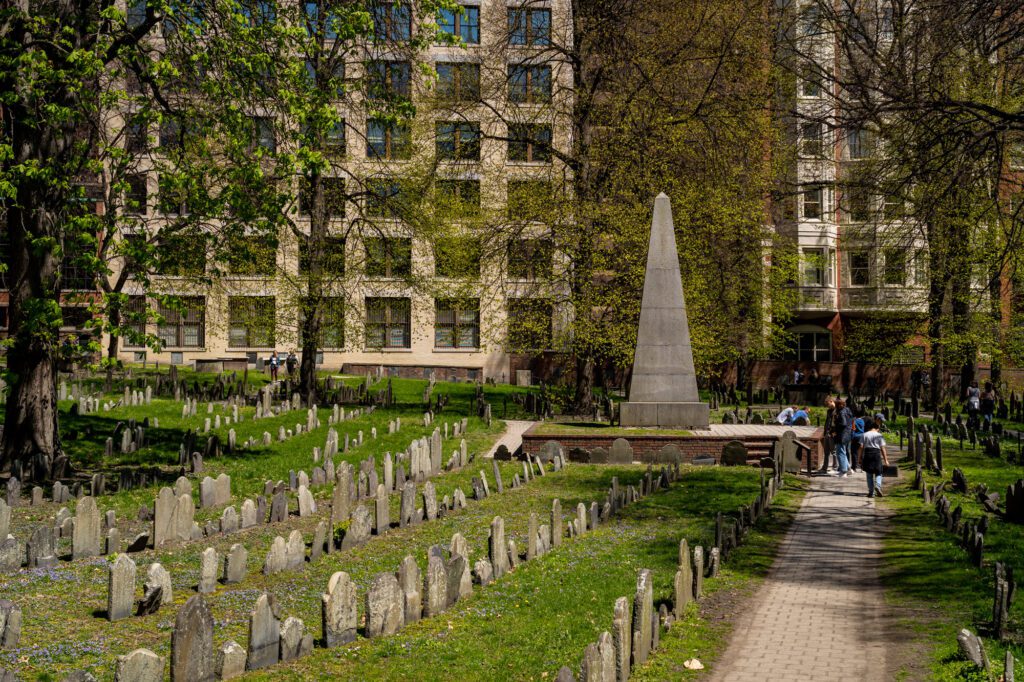
Oh, and then there’s Boston’s City Hall, which is a few hundred yards from the Old State House, which is a brutalist monstrosity made of nothing but concrete and 90 degree angles.
It’s an odd mix of architectural styles, and we found ourselves constantly confused as to how this all came to be.
If there’s one thing to know about Downtown Boston, it’s that it’s about as central as it gets. That’s not always true of downtown areas, but in Boston’s case, it truly is the best area to stay if you’ve only got a day or two, and you want to maximize your time.
You’ll be able to walk to just about everything (Boston is SUPER walkable), and you’ll be within walking distance of most of Boston’s main tourist attractions, like the Old State House, the southern end of the Freedom Trail, and more.
That all being said, it is worth saying that there are parts of it that aren’t super charming, and we think that’s fine. The central location is worth the “charm” tradeoff for short trips and first timers.
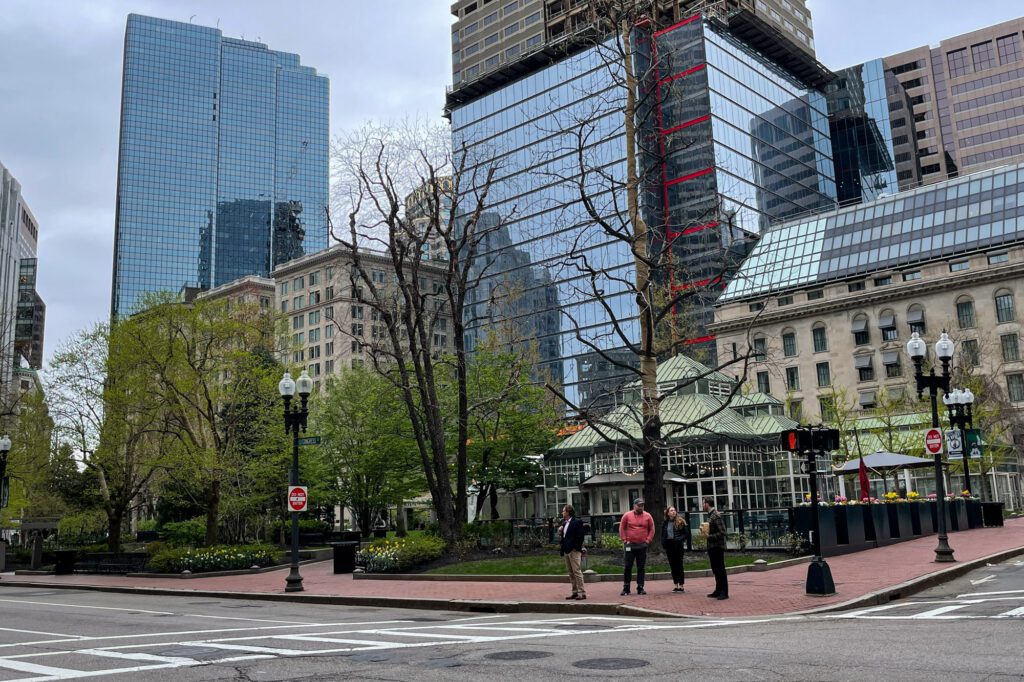
Pros and Cons of Staying in Downtown Boston
Here are the pros and cons of staying downtown as we see them.
Pros of Staying Downtown
It’s central. If you think about Boston as a fan, downtown is basically the handle. Everything else fans out from downtown Boston in all directions.
To the north, you’ve got the north end. South is – unsurprisingly – the south end. West is Back Bay, and east is Seaport. It’ll all be within walking distance if you stay downtown.
It’s well connected to the T. The “T” is Boston’s subway system – the oldest in the country – and it’s not surprising that downtown is littered with metro stops for all of its lines. Basically, wherever you need to go, you’ll be within 5-10 minutes of a stop that will take you there.
Cons of Staying Downtown
It can be a concrete jungle. One of the things that surprises us about downtown Boston is that, from above or outside, it looks like it’s all modern high rises.
But once you’re actually in downtown, especially near the Old State House, there’s more brick and charm than it looks like from afar.
However, there are definitely parts of Downtown Boston that feel like a concrete jungle – especially the further south you go. Not as charming as, say, Back Bay, but that’s not really the point of staying here I suppose.
It’s pricier. The average price of hotels is already fairly high in Boston, and there aren’t all that many budget options in Downtown Boston.
It’s all mid-range hotels and up, many catering to business travelers. If you’re on a budget, we’d probably stay elsewhere (in the South End).
The Best Places to Stay in Downtown Boston
Here are a couple of hotels in Downtown Boston that caught our eye. We either bookmarked them as we were searching for our own stay, or as we were putting together this guide.
The Godfrey Hotel: A Gorgeous Boutique Hotel
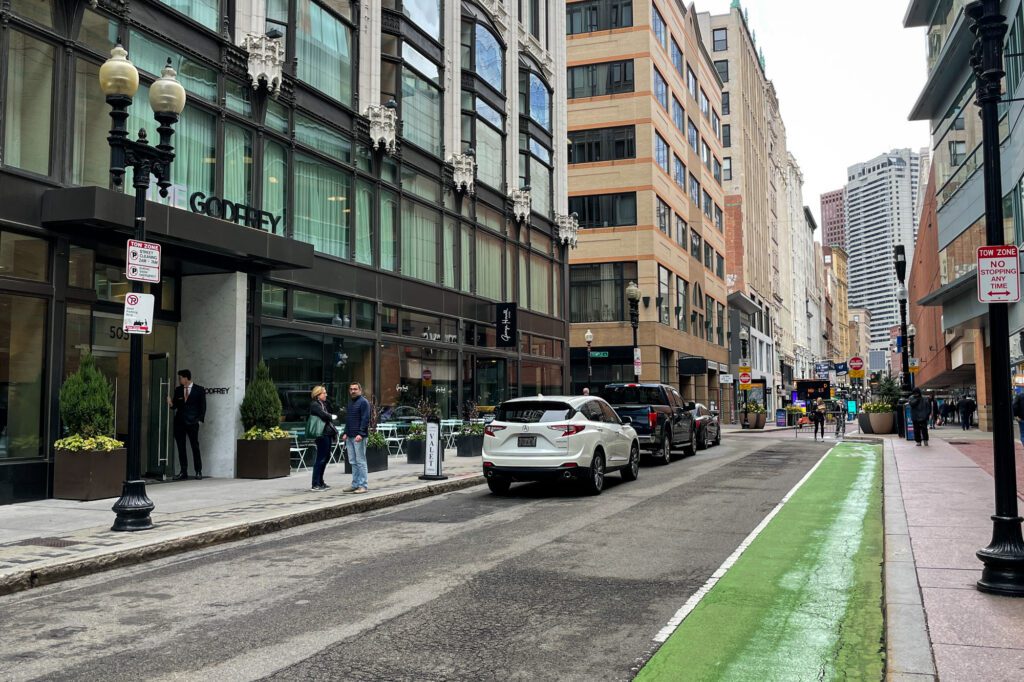
We’re familiar with the Godfrey Hotel because one of the best coffee shops in Boston, George Howell, is on the ground floor. And Matt HAD to go there. Twice.
It’s a solid mid-range option and while the exact location on Washington Street isn’t the greatest, the location a few blocks from Boston Common is fantastic.
If you stay at the Godfrey, you’ll find yourself just a short walk away from most of central Boston’s main sights.
Rooms are modern and comfortable, especially considering the price. You’re not going to get all the design elements that you might get at a super hip boutique hotel, but you’ve got everything you need for a nice stay and a good night of sleep.
Plus, some rooms have more space and / or city views (though it’ll cost a little bit extra).
Side note: There is a $30 “urban fee” that covers amenities like the gym and free Wifi. We HATE these fees, which usually go by terms like “resort fee.” It’s absurd that the rate you see on their site / other booking sites isn’t actually the rate you pay. Make sure to account for that extra fee in your budgeting.
The Harborside Inn: A surprisingly Good Value
Located on the eastern end of Downtown, the Harborside Inn is situated in the best area of the downtown core where you’ll find tourist attractions like Faneuil Hall, Quincy Market, and the Old State House (among other things).
It’s right on the greenway, which means you’ll be an easy walk away from the North End and across the water to the Seaport District.
Rooms are nothing particularly special, although I will say that I like the style of the rooms with exposed brick. The rooms with exterior windows, while a little bit louder because they’re on the street side, look to be much more inviting with more natural light.
They also have rooms on the ground floor with no windows, which they’re marketing as “good for light sleepers.” Which we chuckled at.
The Moxy Downtown Boston: A Modern Mid-Range Option
There’s an important thing to know about Moxy Hotels before you book the Moxy Hotel in Boston, but provided that you know what you’re getting yourself into, we like these hotels, which are Marriott’s hip, boutique hotel brand.
The thing to know is that you’re not going to get a huge room here, with plenty of space to spread out and lounge on a couch.
But you are going to get a well-thought out room with stylish touches, a comfortable bed, and nice views thanks to big windows (if you choose a room with a view).
If you read reviews of basically any Moxy Hotel, the main complaint is that the room is a little small, and it feels more expensive than it should be.
The concept probably works best for shorter trips, where you’ll be spending most of your time outside of the room. Like, say, if you’re spending a weekend in Boston.
The whole idea here is that your room should be one thing – a good place to sleep and shower. High thread count sheets and walk-in showers accomplish that goal. The rest of the time, you should be out exploring!
If you do need a space to hang out in the hotel to relax or get some work done, they have nice common spaces.
If you need some of the more niche amenities that old school hotels have in each room (an ironing board, for example), they have separate public spaces with those amenities for you to use.
Overall, if you’re good with a smaller-than-average room, this is a great, hip, young-feeling home base in Boston. If you’d like a little more space or you’re staying for more than 2-3 days, you might want more space and should probably look elsewhere.
Resort fee: You should know that there’s a $25 a night resort fee here, which covers the gym, Wifi, and other amenities. It’s not optional, and we really wish this trend would die and they would just bake that into the price.
The South End: A More Laid Back, Local Alternative (Plus, Budget-Friendly!)
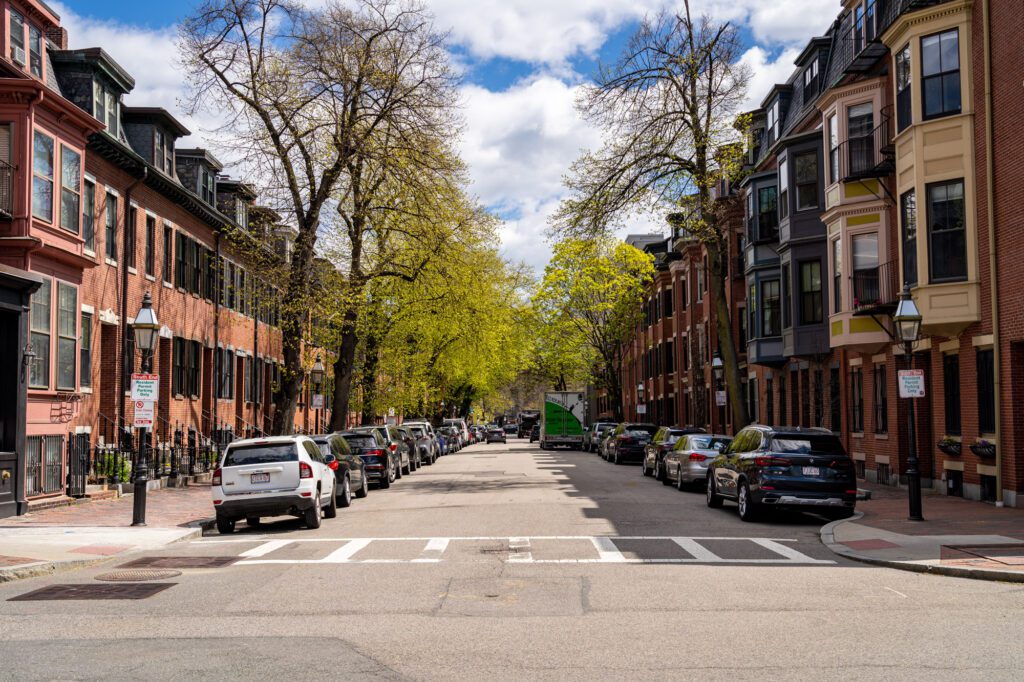
The South End, especially the area just south of downtown, is all red brick and charming stoops. At points, it almost feels Victorian, which we’re familiar with having most recently lived in San Francisco.
As we walked south into the heart of the South End, we passed a big public park with a dog park and a set of basketball courts where, on a sunny spring Saturday morning, it was packed to the gills with locals chatting as their dogs chased various balls and sticks, and regulars taking advantage of the nice weather to get a few pickup games in.
The more we learned about it, the more we realized that this is an underrated home base for exploring Boston.
Is it the most central neighborhood? No, definitely not.
Is it the most charming neighborhood in Boston, where you’ll be surrounded by locals and have a huge variety of bars, restaurants, coffee shops, and more on your temporary doorstep? We think yes.
It is worth noting that this is a heavily gentrified area. In the 1950’s, the city began a process that they called “Urban Renewal,” which at its core involved leveling city blocks of dense housing (at the time, the population was mainly immigrants and minority families) and rebuilding the area to appeal to middle and upper class white families.
Similar to neighborhoods like the Mission District in San Francisco and Capitol Hill in Seattle, it started to become an affordable area for artists to live before, decades later, becoming one of the trendiest places in all of Boston.
The consequence of that transformation is that poorer, largely minority residents have been pushed out due to skyrocketing prices.
We’re not trying to lecture you or tell you not to stay there. We just told you that we enjoyed the South End! We’re telling you that the context is important, and it’s worth thinking about as you’re enjoying the modern version of the South End.
Pros and Cons of Staying in the South End
Here are the pros and cons of staying in the South End.
Pros of Staying in the South End
Great food and drinks. From small bakeries to cool eateries, you could spend your entire time in Boston exploring the food and drink scene in this neighborhood.
Fewer tourists. Most tourists just don’t have the time to make it down this far, so the population here is made up more of locals than tourists. Which is a vibe we kind of like (in some cases).
Cool hotels. There are a couple of hotels here (that also happen to be in a good location as far as being more central). The Revolution Hotel is one of the cooler hotels in Boston as far as we’re concerned, and that’s probably our #1 recommendation in the area.
It’s cheaper. Nothing in Boston is really cheap, but relatively speaking, this is one of the more affordable spots to stay in Boston (which is counterintuitive, because it’s one of the more upscale neighborhoods in the city).
Cons of Staying in the South End
It’s less central. If you’ve got a short trip, you’ll probably want to base yourself a little more centrally.
Fewer “things to do”. In a traditional sense, there are no big things to see in the neighborhood (though there are plenty of places to eat, drink, and there are some cool markets to explore).
The Best Places to Stay in the South End
There are a couple of cool hotels in the South End, most are concentrated in the area immediately adjacent to Back Bay, which is a more convenient location than other places deeper into the neighborhood.
The Revolution Hotel: A Charming Boutique Hotel
Inspired by the rebellious spirit that, we learned on our trip, is pretty much a constant undercurrent through Boston’s history, this is a charming boutique hotel in the South End.
I like that they’ve designed their space so that there are rooms for different budgets available. There are two types of hotel-style rooms – rooms with a bathroom in the room, and rooms with a single-occupant bathroom down the hall, the latter of which are a little bit cheaper.
If you’re looking for more space, they also have lofts and suites with kitchenettes and more living space to spread out (with BEAUTIFUL leather couches, which we’re very much into).
Parking is available in their garage for $30 a day, BUT there are no in/out privileges, so if you’re planning on driving around Boston, it might not be the best choice (though, you don’t really need a car in Boston anyway).
They have a fitness room – with Peloton bikes – free use of their bikes to get around, and a spacious lobby with plenty of room to set up a workstation if the desk in the room isn’t doing it for you.
Oh, and it’s dog-friendly, though there’s a $25 a night amenity fee, which includes a bed, a bowl, and snacks for the pup.
The Upton: Nice, Furnished Apartments
First of all, it’s worth noting that these are apartments, so if you’re looking for a hotel, this ain’t it.
It’s also worth noting that, because you’re getting more space and amenities in your room, it’s going to be more expensive than some standard hotel rooms in Boston.
If more space and kitchen amenities are things you value (like we do), then that slight price increase probably isn’t a huge deal for you.
When we stay in a city for more than a couple of days, we almost always try to stay in an apartment mainly so that we have the ability to cook for ourselves (eating out everyday for a week is brutal on our bodies).
We like the Upton because, like one of the places we stayed in London, it combines the positives of both hotels and apartments.
There’s staff onsite to help you out, hold onto your bags if you check in early or check out late, and whatever else you might need, which is a definite positive of staying in a hotel.
But the apartments are more spacious than a hotel room, and offer you the ability to cook, work from your room more comfortably, and more.
Each apartment has a slightly different layout – which makes sense because the building is an old South End brownstone – and all have full kitchens including stoves, dishwashers, and ovens.
Plus, washer and dryer in the building, high-speed internet, and contactless check in.
The apartments range in size – some are studios, some are one bedrooms – and because they’re in a Victorian, they’ve done a nice job of retaining some of that character in the way they’ve decorated the place.
Worth noting: Max occupancy for each unit is 2-3 people, so bigger groups would need to book separate units to accommodate more than that.
Staypineapple: A Solid Value in Boston
As a general rule, Staypineapple hotels generally offer a good value and location in basically any city in the U.S.
The location in Boston is in the South End, but in a part of the neighborhood that is basically inside a triangle that borders downtown and Back Bay. It’s a nice, walkable location.
Comfortable beds, efficient layouts, and affordable prices are the name of the game here.
Beware: Another resort fee, this one is a little cheaper ($15 a day) but equally infuriating. JUST BUILD IT INTO THE COST OF THE ROOM, OR LET PEOPLE OPT IN/OUT TO WHAT THEY WANT. But, of course, capitalism always wins in the end.
Allegedly, the resort fee covers bottled water (please drink tap water), internet, in-room coffee and tea, and complimentary use of their beach cruisers.
So… just the Wifi for most people?
We hate this trend of resort fees, especially when these amenities should come standard (with the exception of beach cruisers, which I’m guessing nobody uses anyway).
Still, despite that rant about resort fees, it’s still a solid value, especially considering the astronomical prices of some hotels in Boston. And we like the area, which is why it’s on this list.
Planning a trip to Boston? Don’t miss our guide to planning an amazing Boston weekend itinerary.
If you have Celiac Disease, you’ll definitely want to read our guide to the best gluten free restaurants and bakeries in Boston.
More Northeast USA Travel Guides
If you like this guide, you won’t want to miss our other travel guides for the northeast!
New York City
- 3 Days in New York City: A Perfect Long Weekend in NYC
- Where to Stay in New York City: The Best Areas + Hotels
- Gluten Free New York City: The Best GF Restaurants + Bakeries
Boston
- A Weekend in Boston: A Perfect 2 Day Boston Itinerary
- Where to Stay in Boston: A Complete Guide to the Best Areas
- Gluten Free Boston: A Complete Guide for Celiacs
Philadelphia
